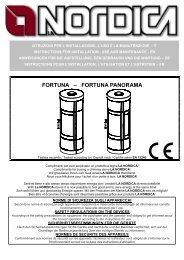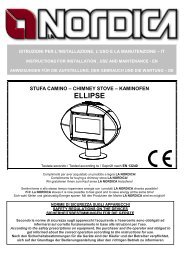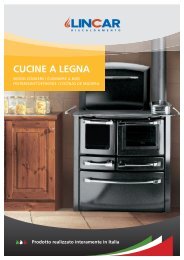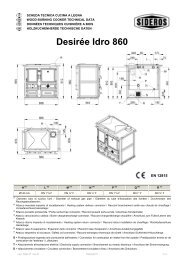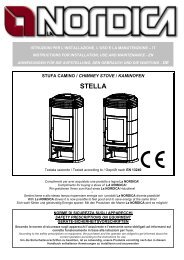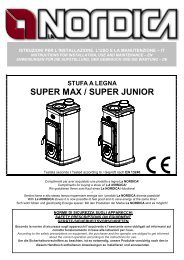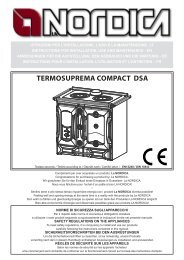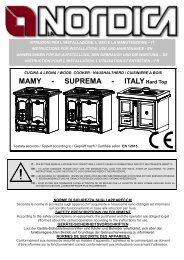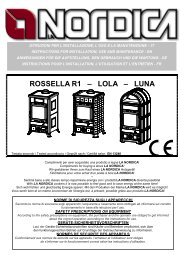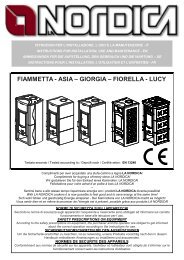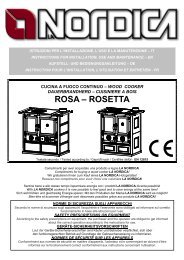CUCINOTTA / CUCINOTTA FORNO
CUCINOTTA / CUCINOTTA FORNO
CUCINOTTA / CUCINOTTA FORNO
You also want an ePaper? Increase the reach of your titles
YUMPU automatically turns print PDFs into web optimized ePapers that Google loves.
<strong>CUCINOTTA</strong> – <strong>CUCINOTTA</strong> Forno<br />
The air entrance for combustion into the installation place must not be closed during the operation of the<br />
cooker. It is absolutely necessary that in the environment in which the cookers operate with the natural flue<br />
of the chimney, it is introduced as much air as necessary for the combustion, i.e. up to 20 m3/hour.<br />
The natural recirculation of air must be ensured by some fixed openings on the outside. The size of the<br />
necessary openings for air is fixed by the relevant prescriptions. Ask information to your chimney sweeper.<br />
The openings should be protected with grids and should never be obstructed.<br />
An extraction hood (aspirating) installed in the same room or in a room<br />
nearby, causes depression with output of combusted gasses (smoke,<br />
smell) even if the hearth door closed. As consequence a contemporary<br />
operation of the hoods is not possible.<br />
The depression in an extraction hood can at worst hypothesis,<br />
transforms the flue into an external air intake, by sucking the smokes<br />
of the rooms with dangerous consequences for the people.<br />
A<br />
Picture 8<br />
OPTIONAL<br />
For a total comfort and relative oxygenation of the same environment, the combustion air of the cooker can<br />
be taken directly from outside. In order to do it, the cooker can be connected to the external air intake<br />
through an optional junction. (Picture 8 C) (Kit Ø120).<br />
8. ADMITTED / NOT ADMITTED FUEL<br />
The fuels admitted are wood logs. One must use only logs of dry wood (water content max. 20 %). The<br />
size of wood logs should be 30 cm’s long and 30 cm’s max in circumference.<br />
The wood used as fuel must have a moisture contents lower than 20%, which is obtained after at least 1<br />
year drying (tender wood) or 2 years (hard wood) and must be stored in a dry and ventilated place (for ex.<br />
Under a shed). The wet wood makes ignition more difficult because it is necessary a greater quantity of<br />
energy to evaporate the existing water. The humid contents has the disadvantage that, with the<br />
temperature lowering, the water condensates first in the hearth and then in the chimney. The unseasoned<br />
wood contains about 60 % of H20, then it is not suitable to be burnt.<br />
The following cannot be burnt: rests of coal, cutoffs, parts of barks and panels, wet wood or treated<br />
with varnished, plastic materials. In this case the guarantee on the appliance lapses. Paper and<br />
carton must be used only for ignition.<br />
National law on the protection against emissions forbids the combustion of wastes. This may damage the<br />
cooker and the chimney, causing health damages and claims by the neighbourhood owing to the bad<br />
smell. The wood is not a fuel, which allows a continuous operation of the appliance, as consequence the<br />
heating all over the night is not possible.<br />
Variety Kg/mc<br />
KWh/Kg<br />
moistness 20%<br />
Beech 750 4,0<br />
Oak 900 4,2<br />
Elm 640 4,1<br />
Poplar 470 4,1<br />
Larch* 660 4,4<br />
Spruce* 450 4,5<br />
Scots pine * 550 4,4<br />
*RESINOUS WOOD NOT SUITABLE FOR THE BURNING<br />
ATTENTION: the continuous and protracted use of aromatic wood (eucalyptus, myrtle etc.) quickly<br />
damages the cast iron parts (cleavage) of the product.<br />
22 7093101 – Rev.05 – EN



